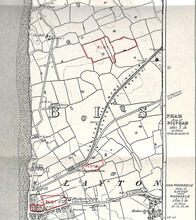Following the great flood of 1719/20 £103 was collected to help the residents of Lytham. However as this was only a small potion of the total loss of £2,055 it was difficult to decide to whom this should be allocated. So instead it was decided to add the £103 to certain charitable gifts that had been made a few years earlier. In 1702, James Threlfall, who appears as minister of Lytham and in a visitation is described as vicar of Lytham 1674-1708 gave £5 for poor children’s schooling. His example was to be followed by William Elston who died in 1704 and his will left £3-3-0 to make a free school. He was employed part time on the estate and in 1694 in the Steward’s Account book received 15 shillings for half a year’s work. He was also a churchwarden in 1678. John Shephard of Mythop, who died in 1726, gave £10 in trust to his heirs and the minister of Lytham and his successors, the profit to be devoted for the use only of poor children’s schooling. It may be interesting to note that the concern leading these original benefactors to promote schooling may have been influenced by the number of people in the village who could neither read nor write as is indicated by the men who made their marks for identification.
There was at this time a private school but no endowed schools until Mr. Silcock was appointed as schoolmaster to the first Lytham School. In 1728 John Harrison gave the residue of his estate to Timothy Pollard and Richard Salthouse in trust for such charitable use as they should think proper for the Township of Lytham. William Gaulter, whose gift is worth recording in 1745, gave several securities yielding £99 interest which was to be paid yearly to the school master. The same gentleman also bequeathed the residue of his estate in trust to William Gaulter and John Webster “to place out at interest, and to pay the produce (except twenty shillings)” to the school master “for his better support and maintenance, upon condition that each schoolmaster should, in consideration thereof , teach and instruct, without any gratuity or reward, all such poor children within the Parish of Lytham as should be yearly appointed by the said trustees or their successors” and he directed that the said sum of twenty shillings should be yearly divided equally amongst the trustees and their successors, in order to defray the expenses of their meetings, and as a gratuity for their care and trouble; but in case the school master of Lytham should refuse or neglect to instruct such poor children, or in case the school should be vacant, so that no children could be taught there, then he directed that the money intended for the benefit of the schoolmaster should, during the time of such refusal, or vacancy, be distributed by his trustees as they in their discretion should think proper, amongst the poor inhabitants of such township, whose poor were free or thereby intended to be made free. The residue of William Gaulter’s estate realised £335 and this sum was put out to interest till the year 1754, when it was called in by the trustees and invested in land.
Other gifts for charitable purposes were to follow to benefit the inhabitants of Lytham, relieving of the elderly poor of the parish of Lytham or for the benefit of school learning or other preferment of the poor children. This fund came to be known as the Ancient Lytham Charities and the foundations of a trust as an educational charity. Over time it became called the Lytham Schools Foundation. They have produced a more detailed description of the history of the charity.
It was felt the monies should be invested “to secure them for fear of being lost.” It was at this point that a remarkable thing happened. It is said that the Clifton estate declined to sell the freehold to any of its land in Lytham. Accordingly the trustees looked further afield. A little further along the coast was the village of Layton-with-Warbreck, consisting of no more than 28 houses of which only four had a slate roof, and turf stacks for burning stood at every door. The trustees viewed this area of freehold land and purchased a total of 25 acres.
This turned out to be a very good investment as in later years this became Blackpool and became quite valuable generating income that was used for local schools.
- Lytham Endowed (St. Cuthbert's)
- Heyhouses
- King Edward VII
- Queen Mary
They also provided funding to some other local schools.
If you have additional information or pictures that may usefully added to this page then please get in touch with us.
